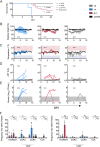Severe Human Lassa Fever Is Characterized by Nonspecific T-Cell Activation and Lymphocyte Homing to Inflamed Tissues
- PMID: 32817220
- PMCID: PMC7565638
- DOI: 10.1128/JVI.01367-20
Severe Human Lassa Fever Is Characterized by Nonspecific T-Cell Activation and Lymphocyte Homing to Inflamed Tissues
Abstract
Lassa fever (LF) is a zoonotic viral hemorrhagic fever caused by Lassa virus (LASV), which is endemic to West African countries. Previous studies have suggested an important role for T-cell-mediated immunopathology in LF pathogenesis, but the mechanisms by which T cells influence disease severity and outcome are not well understood. Here, we present a multiparametric analysis of clinical immunology data collected during the 2017-2018 Lassa fever outbreak in Nigeria. During the acute phase of LF, we observed robust activation of the polyclonal T-cell repertoire, which included LASV-specific and antigenically unrelated T cells. However, severe and fatal LF cases were characterized by poor LASV-specific effector T-cell responses. Severe LF was also characterized by the presence of circulating T cells with homing capacity to inflamed tissues, including the gut mucosa. These findings in LF patients were recapitulated in a mouse model of LASV infection, in which mucosal exposure resulted in remarkably high lethality compared to skin exposure. Taken together, our findings indicate that poor LASV-specific T-cell responses and activation of nonspecific T cells with homing capacity to inflamed tissues are associated with severe LF.IMPORTANCE Lassa fever may cause severe disease in humans, in particular in areas of endemicity like Sierra Leone and Nigeria. Despite its public health importance, the pathophysiology of Lassa fever in humans is poorly understood. Here, we present clinical immunology data obtained in the field during the 2018 Lassa fever outbreak in Nigeria indicating that severe Lassa fever is associated with activation of T cells antigenically unrelated to Lassa virus and poor Lassa virus-specific effector T-cell responses. Mechanistically, we show that these bystander T cells express defined tissue homing signatures that suggest their recruitment to inflamed tissues and a putative role of these T cells in immunopathology. These findings open a window of opportunity to consider T-cell targeting as a potential postexposure therapeutic strategy against severe Lassa fever, a hypothesis that could be tested in relevant animal models, such as nonhuman primates.
Keywords: Lassa fever; Lassa virus; T cells; T-cell homing; host response; pathogenesis; viral hemorrhagic fever.
Copyright © 2020 Port et al.
Figures






References
-
- Lecompte E, Fichet-Calvet E, Daffis S, Koulemou K, Sylla O, Kourouma F, Doré A, Soropogui B, Aniskin V, Allali B, Kouassi Kan S, Lalis A, Koivogui L, Günther S, Denys C, ter Meulen J. 2006. Mastomys natalensis and Lassa fever, West Africa. Emerg Infect Dis 12:1971–1974. doi:10.3201/eid1212.060812. - DOI - PMC - PubMed
-
- Ogbu O, Ajuluchukwu E, Uneke CJ. 2007. Lassa fever in West African sub-region: an overview. J Vector Borne Dis 44:1–11. - PubMed
-
- Ajayi NA, Nwigwe CG, Azuogu BN, Onyire BN, Nwonwu EU, Ogbonnaya LU, Onwe FI, Ekaete T, Günther S, Ukwaja KN. 2013. Containing a Lassa fever epidemic in a resource-limited setting: outbreak description and lessons learned from Abakaliki, Nigeria (January-March 2012). Int J Infect Dis 17:e1011–e1016. doi:10.1016/j.ijid.2013.05.015. - DOI - PubMed
-
- Kafetzopoulou LE, Pullan ST, Lemey P, Suchard MA, Ehichioya DU, Pahlmann M, Thielebein A, Hinzmann J, Oestereich L, Wozniak DM, Efthymiadis K, Schachten D, Koenig F, Matjeschk J, Lorenzen S, Lumley S, Ighodalo Y, Adomeh DI, Olokor T, Omomoh E, Omiunu R, Agbukor J, Ebo B, Aiyepada J, Ebhodaghe P, Osiemi B, Ehikhametalor S, Akhilomen P, Airende M, Esumeh R, Muoebonam E, Giwa R, Ekanem A, Igenegbale G, Odigie G, Okonofua G, Enigbe R, Oyakhilome J, Yerumoh EO, Odia I, Aire C, Okonofua M, Atafo R, Tobin E, Asogun D, Akpede N, Okokhere PO, Rafiu MO, Iraoyah KO, Iruolagbe CO, Akhideno P, Erameh C, Akpede G, et al. . 2019. Metagenomic sequencing at the epicenter of the Nigeria 2018 Lassa fever outbreak. Science 363:74–77. doi:10.1126/science.aau9343. - DOI - PMC - PubMed
Publication types
MeSH terms
Substances
LinkOut - more resources
Full Text Sources
Miscellaneous

